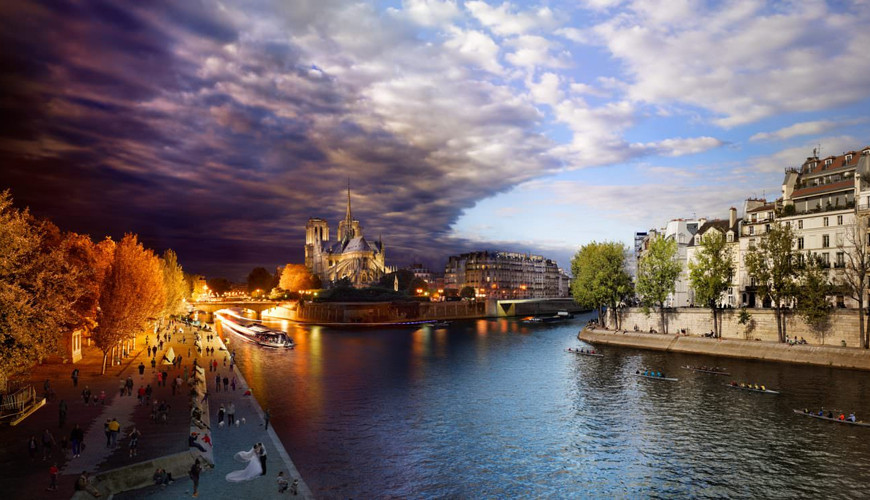Time Lapse Photography

Pont De Le Tournelle, Paris, Day to Night, 2013 © Stephen Wilkes
A few notes from last night's meeting on Time Lapse Photography.
Time lapse photography is a way of compressing time. The amount of compression depends largely on the interval between images and in moving time lapse videos, the frame rate we choose to present the images.
Time lapse is largely used to show changes and movement over time. We might find it used for the following:
- Capturing landscapes/cloudscapes
- The growth of plants and opening of flowers
- Progression of construction projects (massive buildings or Lego builds)
- Movement studies and animal behaviour
- Astrophotography
- As cinematic b-roll, extra footage that may appear between shots to imply the passage of time between scenes or to compress a series of events
The start of Time Lapse Photography
Dr John Nash Ott is considered as the father of time lapse photography. While a banker by trade Dr Ott indulged his fascination with the effects of different types of light on plants (and later animals). He created the first time lapses to show the progression of plant growth over time, it was a great way to illustrate how plants grow under different light reacted. It also showed how plants "move" and instinctively seek out support systems in their environment. It opened the world to all sorts of studies that could now be documented in whole, even when there were no people there to observe the happenings.
Considerations
- For the best outcome, set everything manually, especially if you're shooting JPGs. And we mean everything. Focus, ƒ-stop, shutter, ISO, white balance, everything.
- Slow down movement using ND Filters, allowing you to extend the time your shutter is open adding a bit of blur to your shots.
- The minimum frame rate for moving time lapse videos is 12 frames per second, anything less will result in jerky movement.
- Standard frame rates are 24 / 25 / 30 frames per second.
- To find out how many photos you need, multiply the number of frames by the length time in seconds.
A minute and a half video will require 90 x 24 images, a total of 2,160 images.
If you have a half second exposure and a one second interval you'll need around 54 minutes to capture these images. - Because of the time it takes to capture your source material for your time lapses, it can be a solitary event. There are few partners or companions who hare happy to wait around with you for 54 minutes so you can get 1.5 minutes of footage.
How To
- Andyax: The Power of Time-Lapse
- Night-cap Images (Richard Tatti): Nightscape Light Painting Star Trails
- Matti Haapoja: The Best Settings for Timelapses
Cool to watch
- Stephen Wilkes Day-To-Night series of images
- GPhase: Bean Time-Lapse - 25 days
- Andrew Huang: Slow Down
How he did it
-
Winnetka Historical Society: Exploring the Spectrum Pumpkin | John Nash Ott
Equipment
Intervalometer
Check your camera manual, many cameras have Interval timers built in so you may not need extra equipment to make it work.
If you don’t have that you can get one from eBay for around $15-30 http://bit.ly/2qPOgaJ
Search eBay for your camera model to ensure you get the right one. A “canon” version may not be enough, you might have to get one specific to your type.
Many manufacturers have much more expensive versions that do exactly the same thing.
Allan Williams sent me an email over night telling me about the “Timelapse+ VIEW" this device has some crazy amazing features including auto-ramping which will adjust your settings for time lapses that move from day to night. At US$399, she’s not an inexpensive bit of kit. See it at https://www.timelapseplus.com
Allan also included Richard Tatti's video using the Timelapse+ VIEW.
Movement Devices
In Matti's video above he mentions one way to make your time lapse videos look more "cinematic" is to use a rail slider. But these don't come cheap. You can get manual siders, which can be great when making real-time photos, but for time lapses you may find it difficult to get a fluid movement without having a slider that moves for you automatically. I haven't yet used one of these myself so I have nothing to recommend, however, you can investigate "motorised camera sliders" and you'll find an array of options available.
There are also "motorised pan and tilt heads" you can get for a different kind of motion, or combine a pan and tilt with a slider for even more.
ND Filter
You can use an ND filter to make your individual photos contain some motion blur, giving your time lapse a greater sense of movement. It's a stylistic choice and may not work in all situations. While it may work in movement of people, cars, etc, I wouldn't likely use one for a cloudscape where you want the fluid rolling movement of the clouds.
Conclusions
Time lapse photography can be interesting and fun. For more information on astrophotography, check out our notes from our meetings with Richard Tatti and Alex Cherny
Richard is the man behind Nightscape Images and he runs regular nightscape workshops on astrophotography and light painting, many of our members recommend his courses. He also has a Nightscape Images YouTube channel where he shares a lot of information.
If you make any time lapse images or videos, share them with us... send them to webmaster@williamstowncameraclub.com.au and we'll share them with our members.